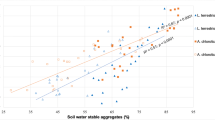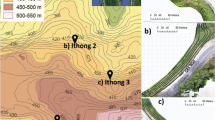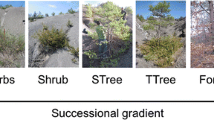Abstract
Background and aims
Soil organisms are known to engineer the soil physical properties, but their impact is difficult to assess and poorly documented. Shrinkage analysis has a good potential for such assessment. This study analyses the effects of mycorrhizae (Glomus intraradices), earthworms (Allolobophora chlorotica) and two plants, Allium porrum (leek) and Petunia hybrida (petunia), on the physical properties of an unstable loamy Luvisol, as well as the biological interactions between the soil organisms.
Methods
In addition to soil organism biomass, shrinkage analysis and soil aggregate stability analysis were used to characterize the soil physical properties.
Results
The soil aggregate stability, specific volume and structural pores volumes were increased with plant roots compared to control. The drilling effect of roots could not explain the pore volume increase, which was several orders of magnitude larger than the volume of the roots. Leek had larger impact on volumes while petunia mostly increased soil aggregate stability. Mycorrhizae increased the soil stability and the soil volume. Earthworms alone decreased the pore volumes at any pore size, and plant roots mitigated this.
Conclusions
Our results highlight (1) the large impact of soil biota on soil physical properties, (2) that their separated effects can either combine or mitigate each other and (3) that the observed changes are varying in intensity according to soil type and plant type.






Similar content being viewed by others
References
Amezketa E (1999) Soil aggregate stability: a review. J Sustain Agric 14(2–3):83–151
Angers DA, Caron J (1998) Plant-induced changes in soil structure: processes and feedbacks. Biogeochemistry 42(1–2):55–72
Angle JS, McGrath SP, Chaney RL (1991) New culture-medium containing ionic concentrations of nutrients similar to concentrations found in the soil solution. Appl Environ Microbiol 57(12):3674–3676
Boivin P (2007) Anisotropy, cracking, and shrinkage of vertisol samples—experimental study and shrinkage modeling. Geoderma 138(1–2):25–38
Boivin P, Brunet D, Gascuel-Odoux C (1990) Une nouvelle méthode de mesure de la densité apparente sur échantillons de sols non remaniés. Bull Group Fr Humidimétrie Neutron Tech Assoc 28:57–71
Boivin P, Garnier P, Tessier D (2004) Relationship between clay content, clay type, and shrinkage properties of soil samples. Soil Sci Soc Am J 68(4):1145–1153
Boivin P, Schaeffer B, Temgoua E, Gratier M, Steinman G (2006) Assessment of soil compaction using shrinkage curve measurement and modeling. Experimental results and perspectives. Soil Tillage Res 88:65–79
Bradford MA, Jones TH, Bardgett RD, Black HIJ, Boag B, Bonkowski M, Cook R, Eggers T, Gange AC, Grayston SJ, Kandeler E, McCaig AE, Newington JE, Prosser JI, Setala H, Staddon PL, Tordoff GM, Tscherko D, Lawton JH (2002) Impacts of soil faunal community composition on model grassland ecosystems. Science 298(5593):615–618
Braudeau E (1988) General shrinkage curve equation for undisturbed soil samples. C R Acad Sci II 307(15):1731–1734
Braudeau E, Bruand A (1993) Détermination de la courbe de retrait de la phase argileuse à partir de la courbe de retrait sur échantillon de sol non remanié. Application à une séquence de sols de Côte-d’Ivoire. C R Acad Sci II 316(5):685–692
Braudeau E, Costantini JM, Bellier G, Colleuille H (1999) New device and method for soil shrinkage curve measurement and characterization. Soil Sci Soc Am J 63(3):525–535
Braudeau E, Frangi JP, Mohtar RH (2004) Characterizing nonrigid aggregated soil-water medium using its shrinkage curve. Soil Sci Soc Am J 68(2):359–370
Brewer R (1964) Fabric and mineral analysis of soils. Wiley, New York
Brown GG, Edwards CA, Brussaard L (2004) How earthworms affect plant growth: burrowing into the mechanisms. In: Edwards CA (ed) Earthworm ecology. CRC, Boca Raton, pp 13–49
Carter MR, Angers DA, Kunelius HT (1994) Soil structural form and stability, and organic-matter under cool-season perennial grasses. Soil Sci Soc Am J 568:1194–1199
Chauvel A, Grimaldi M, Barros E, Blanchart E, Desjardins T, Sarrazin M, Lavelle P (1999) Pasture damage by an Amazonian earthworm. Nature 398:32–33
Chen DH, Saleem Z (1986) A new simplex procedure for function minimization. Int J Model Simul 6(3):81–85
Chenu C, Abiven S, Annabi M et al (2011) Mise au point d’outils de prévision de l’évolution de la stabilité de la structure de sols sous l’effet de la gestion organique des sols. Etude Gestion Sols 18(3):161–174
Cosentino D, Chenu C, Le Bissonnais Y (2006) Aggregate stability and microbial community dynamics under drying-wetting cycles in a silt loam soil. Soil Biol Biochem 38:2053–2062
Crawford JW, Deacon L, Grinev D, Harris JA, Ritz K, Singh BK, Young I (2012) Microbial diversity affects self-organization of the soil-microbe system with consequences for function. J R Soc Interface 9:1302–1310
Edwards CA, Bohlen PJ (1996) Biology and ecology of earthworms, 3rd edn. Chapman & Hall, London
Eisenhauer N, König S, Sabais ACW, Renker C, Buscot F, Scheu S (2009) Impacts of earthworms and arbuscular mycorrhizal fungi (Glomus intraradices) on plant performance are not interrelated. Soil Biol Biochem. doi:10.1016/j.soilbio.2008.12.017
Endlweber K, Scheu S (2006) Establishing arbuscular mycorrhiza-free soil: a comparison of six methods and their effects on nutrient mobilization. Appl Soil Ecol 34:276–279
Feeney DS, Crawford JW, Daniell T, Hallett PD, Nunan N, Ritz K, Rivers M, Young IM (2006) Three-dimensional microorganization of the soil-root-microbe system. Microb Ecol 52(1):151–158
Haines WB (1923) The volume-changes associated with variations of water content in soil. J Agric Sci 13:296–310
Hallett P, Feeney D, Bengough A, Rillig M, Scrimgeour C, Young I (2009) Disentangling the impact of AM fungi versus roots on soil structure and water transport. Plant Soil 314(1–2):183–196
Haynes RJ, Beare MH (1997) Influence of six crop species on aggregate stability and some labile organic matter fractions. Soil Biol Biochem 29(11–12):1647–1653
Jastrow JD, Miller RM (1991) Methods for assessing the effects of biota on soil structure. Agric Ecosyst Environ 34(1–4):279–303
Jastrow JD, Miller RM, Lussenhop J (1998) Contributions of interacting biological mechanisms to soil aggregate stabilization in restored prairie. Soil Biol Biochem 30(7):905–916
Kemper WD, Rosenau RC (1986) Aggregate stability and size distribution. In: Klute A (ed) Methods of soil analysis, Part 1. Physical and mineralogical methods, Vol. 1, vol 5, 2nd edn, Soil Science Society of America Book Series. Soil Science Society of America, Madison, pp 425–442
Koide RT, Li MG (1989) Appropriate controls for vesicular arbuscular mycorrhiza research. New Phytol 111(1):35–44
Lawrence GP (1977) Measurement of pore sizes in fine-textured soils—review of existing techniques. J Soil Sci 28(4):527–540
Le S, Josse J, Husson F (2008) FactoMineR: an R package for multivariate analysis. J Stat Softw 25:1–18
Li H, Li X, Dou Z, Zhang J (2012) Earthworm (Aporrectodea trapezoides)-mycorrhiza (Glomuns intraradices) interaction and nitrogen and phosphorus uptake by maize. Biol Fertil Soils 48:75–85
McGonigle TP, Miller MH, Evans DG, Fairchild GL, Swan JA (1990) A new method which gives an objective-measure of colonization of roots by vesicular arbuscular mycorrhizal fungi. New Phytol 115(3):495–501
Miller RM, Jastrow JD (1990) Hierarchy of root and mycorrhizal fungal interactions with soil aggregation. Soil Biol Biochem 22(5):579–584
Milleret R, Le Bayon RC, Gobat JM (2009a) Root, mycorrhiza and earthworm interactions: their effects on soil structuring processes, plant and soil nutrient concentration and plant biomass. Plant Soil 316(1–2):1–12. doi:10.1007/s11104-008-9753-7
Milleret R, Le Bayon RC, Lamy F, Gobat JM, Boivin P (2009b) Impact of roots, mycorrhizas and earthworms on soil physical properties as assessed by shrinkage analysis. J Hydrol 373(3–4):499–507. doi:10.1016/j.jhydrol.2009.05.013
Pelosi C, Bertrand M, Roger-Estrade J (2009) Earthworm community in conventional, organic and direct seeding with living mulch cropping systems. Agron Sustain Dev 29:287–295
R Development Core Team (2007) R: a language and environment for statistical computing. R Foundation for Statistical Computing, Vienna, Austria. http://www.R-project.org
Rillig MC, Mummey DL (2006) Mycorrhizas and soil structure. New Phytol 171(1):41–53
Rillig MC, Wright SF, Eviner VT (2002) The role of arbuscular mycorrhizal fungi and glomalin in soil aggregation: comparing effects of five plant species. Plant Soil 238(2):325–333
Schaeffer B, Schulin R, Boivin P (2008) Changes in shrinkage of restored soil caused by compaction beneath heavy agricultural machinery. Eur J Soil Sci 59(4):771–783
Scheu S (2003) Effects of earthworms on plant growth: patterns and perspectives. Pedobiologia 47(5–6):846–856
Six J, Bossuyt H, Degryze S, Denef K (2004) A history of research on the link between (micro)aggregates, soil biota, and soil organic matter dynamics. Soil Tillage Res 79(1):7–31
Tessier D (1980) Sur la signification de la limite de retrait des argiles. CR Acad Sci Paris 291D:377–380, In French
Thomas RS, Franson RL, Bethlenfalvay GJ (1993) Separation of vesicular-arbuscular mycorrhizal fungus and root effects on soil aggregation. Soil Sci Soc Am J 57(1):77–81
Tisdall JM, Oades JM (1982) Organic-matter and water-stable aggregates in soils. J Soil Sci 33(2):141–163
Wardle DA, Bardgett RD, Klironomos JN, Setala H, van der Putten WH, Wall DH (2004) Ecological linkages between aboveground and belowground biota. Science 304(5677):1629–1633
Wurst S, Rillig MC (2011) Additive effects of functionally dissimilar above- and belowground organisms on a grassland plant community. J Plant Ecol 4(4):221–227
Wurst S, Dugassa-Gobena D, Langel R, Bonkowski M, Scheu S (2004) Combined effects of earthworms and vesicular-arbuscular mycorrhizas on plant and aphid performance. New Phytol 163(1):169–176
Wurst S, Allema B, Duyts H, van der Putten WH (2008) Earthworms counterbalance the negative effect of microorganisms on plant diversity and enhance the tolerance of grasses to nematodes. Oikos 117(5):711–718. doi:10.1111/j.2008.0030-1299.16333.x
Young IM, Crawford JW (2004) Interactions and self-organization in the soil-microbe complex. Science 304(5677):1634–1637
Yu XZ, Cheng JM, Wong MH (2005) Earthworm-mycorrhiza interaction on Cd uptake and growth of ryegrass. Soil Biol Biochem 37(2):195–201
Zaller JG, Heigl F, Grabmaier A, Lichtenegger C, Piller K, Allabashi R, Frank T, Drapela T (2011) Earthworm-mycorrhiza interactions can affect the diversity, structure and functioning of establishing model Grassland communities. PLoS One 6(12):e29293
Acknowledgments
This project was funded by the National Centre of Competence in Research (NCCR) Plant Survival, a research programme of the Swiss National Science Foundation. The authors are very grateful to Lidia Mathys-Paganuzzi and Marie-Laure Heusler for their excellent technical assistance in the laboratory, to Frederic for supervision of the experimental setup and to François Fullemann for technical assistance during the greenhouse experiment. We are also very grateful to the person responsible for the INRA long-term experiment of La Cage at Versailles, for allowing us to sample the soil, and to Prof. Didier Reinhardt for the Petunia seeds. We finally thank the two anonymous reviewers for their comments and suggestions.
Author information
Authors and Affiliations
Corresponding author
Additional information
Responsible Editor: Nico Eisenhauer.
Rights and permissions
About this article
Cite this article
Kohler-Milleret, R., Le Bayon, RC., Chenu, C. et al. Impact of two root systems, earthworms and mycorrhizae on the physical properties of an unstable silt loam Luvisol and plant production. Plant Soil 370, 251–265 (2013). https://doi.org/10.1007/s11104-013-1621-4
Received:
Accepted:
Published:
Issue Date:
DOI: https://doi.org/10.1007/s11104-013-1621-4




